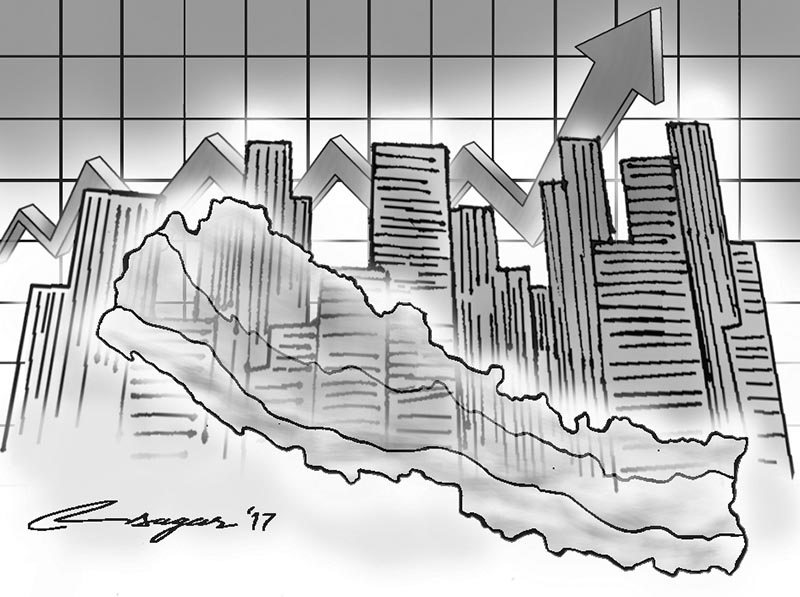Nordic development model: Implications for Nepal
In the present context of globalization, as Nepal has been facing the lack of resources for investment, it needs to create such an environment. Security for foreign investment can help to revitalize the national economy
Sustainable promotion of quality of life of the general public should be the ultimate objective of political parties. It can be possible if the leaders keep people at the center of politics and chalk out plans with strategic vision, mission and goals with respect to the changing socio- political and ecological context of the world. A Constitution has been promulgated through a richly inclusive and representative constituent assembly. Strong political will power, vision and search for viable alternatives andmeticulous implementation can help to institutionalize democracy and to address the needs of people. However for long lasting improvement in the quality of lives of the people according to their changing aspirations and to develop our self-reliance we need to develop strong, sustainable and contextualized development plans.
The Nordic model is a developmental model incorporating a competitive capitalism and a smooth provision for the wellbeing of the general public. In other words, it is an amalgamation of free market economy with a welfare state. The Nordic model insists on the need of political stability for economic growth, and it believes that political stability can be achieved through different social pacts and agreements but not through any sort of tyrannical or authoritative imposition of power. In Nepal too owing to the lack of political stability the pace of developmental activities has been slow. Hence political stability in the nation and different pacts and agreements in the society are necessary in order to increase the pace of development in every nook and corner of the country.
According to the Nordic model the state shoulders not only regulatory responsibilities but also assumes developmental and entrepreneurial roles. Conventionally Nepal has been carrying out regulatory activities and has been formulating and implementing periodic and annual developmental plans and policies. However, as the majority of the projects are donor driven and have been running under project based approaches Nepal has failed to achieve desired outcomes. Similarly, despite having a lot more to do to keep pace with the socio economic and technological advancements in the world there is very limited entrepreneurial intervention of the government that is necessary for strong productivity and higher wellbeing of the people. Following are some features of the Nordic Model and their implications in Nepal. The welfare state envisaged by the Nordic model was based on reformist ideology focused on keeping the social order and stability intact. One of its important features is that it focuses on the need to persuade labor to sacrifice some of the gains in productivity in exchange for increased accumulation and greater employment provided that the increase of profit does not unjustly go to the capitalists only. There is the need to accelerate industrial development in Nepal but at the same time social order and stability are to be kept intact. It is necessary to ensure the access of all the people irrespective of caste, religion, ethnicity and class to employment opportunities and to reduce the increasing gulf between the rich and the poor. The Nordic model advocated the strong budgetary intervention of the government for optimum mass employment. This sort of intervention can help combat unemployment and reduce the increasing brain drain, the drain of labor force and different social evils in Nepal. The Nordic model talks about the provision of controlling the interest rates to create conducive environment for the establishment and growth of industries. Nepal too needs to maintain easy and low interest loans for investment in the industrial sector through suitable monetary and financial policies.
Though the model has accepted the state as an important actor of national business it does not advocate large scale nationalization. Even under a socialist government Sweden was able to provide a conducive environment for large multinational enterprises of the world. In the present context of globalization, as Nepal has been facing the lack of resources for investment, it needs to create such an environment. Security for foreign investment and strong legal provision to attract foreign and multinational entrepreneurs can help to revitalize the national economy of our country.
At present, Nepal is undergoing a political transition and is in the process of establishing a stable political and governance system so as to speed up the process of development. The Nordic Model has some more remarkable features like the provision for social insurance, social welfare and amicable and sustainable conflict management, balanced and credible role of the state, labor market intervention for higher productivity and mobility of the labor force and stopping labor drain, removal of domestic restrictions on trade, reforms of company laws and banking legislation, harmonious relationship between the employer and the employed etc.
In spite of some dissatisfaction and conflicts the promulgation of the Constitution can be regarded as a political success but if the political changes are not accompanied by the plans to bring about a sustainable change in the quality of lives of people through effective developmental plans and policies they can be lame. As it is among the most successful models of development of the world the Nordic model is worth considering in the context of Nepal.






